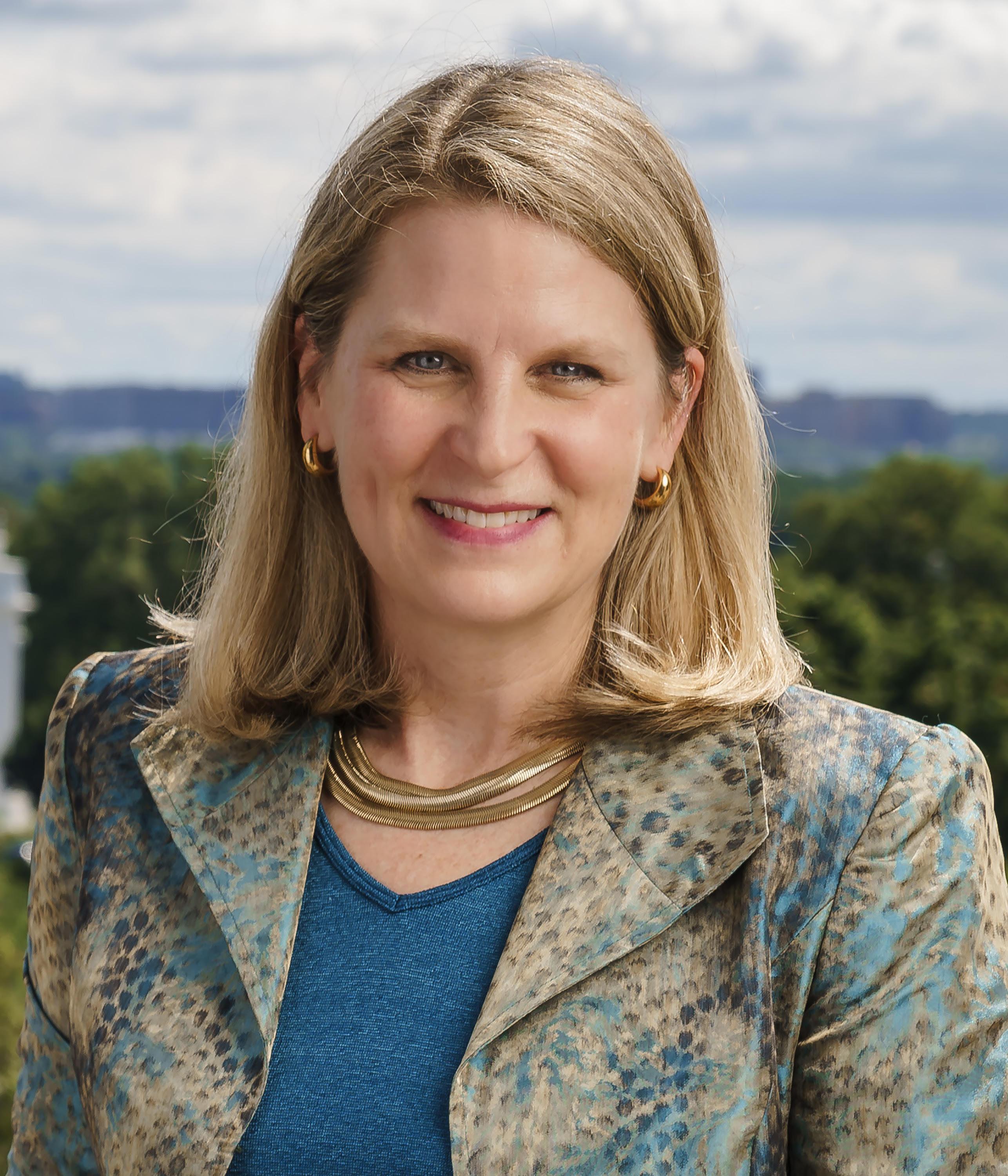For Liz Shuler, the last year has been a whirlwind.
Since she unexpectedly succeeded the late Richard Trumka a year ago, and especially since the AFL-CIO Convention in Philadelphia, new federation President Shuler has raced around the country, addressing 10 union conventions and a new special Smart-TD Union leadership conference in San Francisco just in the last 2-1/2 weeks alone.
She’s held picket-line discussions with workers forced to strike. In Minnesota, youthful organizers loaded her with suggestions on new organizing methods, targets and priorities.
And on Aug. 3, she addressed a special conference of labor, business and government officials in Big Sky, Montana, with a double message.
She reminded them workers are fed up with corporate exploitation and have seized the chance of the coronavirus-induced labor shortage to switch jobs and/or join unions in droves. She noted unions now have enormously positive approval ratings as the country worries about enormous income inequality and its impact, and how to reduce the gap.
What workers really want is a seat at the table about decisions that affect their daily lives—through unions in the AFL-CIO or independent of it. Agreeing to that, rather than labor law-breaking to stop union organizing, is good for business, too, Shuler stated. It produces more-willing workers who stay longer, produce higher-quality products and boost profits.
All this with a vision in mind: To lead/march unions forward into new work sectors, new directions and bottom-up decision making in politics, union leadership and organizing.
Electrical Worker Shuler and her running mate, Secretary-Treasurer Fred Redmond, a Steelworker, got a mandate from convention delegates meeting in Philadelphia in June to do just that: Election, by acclamation, to full terms heading the labor federation. They also got a new Executive Council: More women, more people of color and younger. One is 35 years old.
And though Shuler didn’t paraphrase the phrase in her exclusive interview with Press Associates Union News Service, the AFL-CIO’s first female president wants to show the AFL-CIO is not your father’s—or her father’s—labor federation.
“It’s spelling out our vision, and getting in synch with other organizations” that can work with the nation’s unions “to figure out top priorities,” Shuler explained in the half-hour session that would have been in Washington, D.C., if Shuler hadn’t been traveling all over the United States.
But it’s not just goals—it’s also recruiting new young activists to take the lead, just like the young organizers are doing in Minnesota. That’s needed: Not only are such young workers forming unions on their own, but she wants them to be a rising share of the union movement. Federal data, after all, show the highest union density is among workers ages 45–64. The lowest share is among young workers just joining the labor force, ages 16–24.
At the AFSCME convention in Philadelphia, for example, Shuler not only laid out her vision for the federation’s new Center for Transformative Organizing (CTO,) but also pushed the AFL-CIO’s NextGen project, a longtime cause of hers “to help young people rising up in the labor movement,” she said in the interview.
Then there’s the question of who and how to organize. That’s where the CTO comes in.
“The CTO will bring together the brightest organizers, technologists and researchers,” Shuler had told AFSCME. “We will develop, implement and scale powerful campaigns for unprecedented union growth.
“By concentrating resources and coordinating to achieve the biggest wins, the CTO will use the power of the entire U.S. labor movement.”
Shuler elaborated on that in the interview. Her model is the Retail, Wholesale and Department Store Union’s second organizing drive, for the rerun election this year, at the giant Amazon warehouse in Bessemer, Alabama.
The first vote at Bessemer in 2021 drew national attention and support, including an endorsement from President Joe Biden, actor Danny Glover, Sen. Bernie Sanders of Vermont and others. But Amazon’s labor law-breaking led to a big loss. Amazon’s actions were so illegal, though, the National Labor Relations Board threw the vote out, ordering the rerun.
The campaign before the second vote was quite different, Shuler said. The in-plant organizing committee was “African American and younger,” just like Bessemer’s workforce. It took the lead. The big names stayed out of it.
“We had more than 20 unions and more than 100 organizers working together” to help RWDSU go door to door to workers. “It was the first time we did that at the AFL-CIO.”
The result in Bessemer, so far: RWDSU is trailing, but there are so many challenged ballots they exceed the difference between “yes” and “no” votes. And Amazon engaged in more labor law-breaking in the second campaign, RWDSU says.
The lesson, Shuler says, is to get the entire labor movement behind a big and consequential organizing drive. “We can build a trove of talent and focus on one or two sectors,” she explained. And the CTO “will also be an opportunity to collect best practices” in organizing and train people how to put them into effect.
“What’s old is new: Workers talking with workers,” Shuler says. Amazon, as a matter of fact, will be one of the first, if not the first, target of such joint organizing. At his union’s convention in Chicago, Letter Carriers President Fred Rolando revealed the AFL-CIO is chairing a 12-union coalition to organize Amazon’s “last-mile” drivers, who are now misclassified as “independent contractors.”
The federation also sees a big opportunity in Biden’s $369 billion clean energy plan. In the Inflation Reduction Act, the official name for the bill that includes those projects, Biden and congressional Democrats mandated clean energy projects be built with project labor agreements, for example.
Biden wants the clean energy jobs to be well-paying union jobs, and not just in construction. “We’re looking at a huge investment in clean energy,” says Shuler. “We’re building out expertise in that field," she says. “In one example, we worked with our Danish contemporaries to get Orset,” the builder of a big wind farm off the coast of Rhode Island, to do so with project labor agreements for U.S. construction workers. Jones Act cargo ships will carry windmill components from Texas to Rhode Island. Seafarers members crew those vessels.
“And IBEW members and Utility Workers will maintain those windmills,” says building trades member Shuler.
The windmills are just one clean energy project, a worksite model for “clean energy” programs, projects and tax credits, all designed to cut the carbon emissions that cause global warming while ensuring union workers build those plants, buses, airports, subways, roads, windmills, solar panels and other devices.
Energizing younger workers and moving them into leadership positions is all of a piece with another Shuler goal: Increasing responsibility and decision making by rank-and-file unionists in organizing and in politics. She admits that in past years, the federation has talked that talk, but not all unions have walked the walk.
“We’re looking at our political mobilization through an organizing lens,” Shuler explains. “We’re building it to last by granting resources (money) to our network and sourcing local talent so they’re on the ground” full time and year-round.
That doesn’t mean the AFL-CIO will go out and train every single union organizer, she adds. Each union has its own organizing culture and methods, after all. It does mean the federation, including in politics, “will train the trainers,” who in turn will—she hopes—motivate, educate and train rank-and-file union members.
There are two advantages, she says. One is union members are more likely to listen to, and trust, colleagues on organizing and politics when they meet at worksites or in union halls. That counteracts mass media information, “or misinformation from Facebook and cable news. The other, and this is part of the bottom-up focus, “members can talk to each other about what’s better locally” and tailor both organizing and politics to results of those conversations. “We want to build trust and credibility,” Shuler says.
That goes for politics, too. The federation has targeted nine swing states for maximum effort in this year’s election, and it’s sending in permanent staffers, contacts and money to those state feds “that have a political plan.” Those staffers won’t just “parachute in” and leave after the election, Shuler says. They’ll stay.
Political decision making will be at the local level, too, Shuler says. What the federation can provide, besides the year-round political structure, is education—especially about labor’s accomplishments in D.C., its challenges in states and work it still must do.
If that works, then the new structure “goes all in” nationwide.
There is one big political problem, though, Shuler admits: Connecting the dots between labor’s success on Capitol Hill—working with Biden—and results on the ground. Biden, unions and the narrowly Democratic Congress enacted a raft of pro-worker bills, many designed to yank the nation out of the coronavirus-caused depression that saw joblessness hit double-digits at the height of the pandemic.
But most actual physical results of those measures have yet to appear. Those that have, such as new construction on subways, highways, airport runways, broadband and more, have not been directly connected to the five-year, $1.2 trillion infrastructure and jobs bill labor pushed, mostly Democratic lawmakers enacted and Biden signed.
“Our job is to unpack it,” Shuler says of that measure, the Inflation Reduction Act, and the other pro-worker legislation the coalition of labor, lawmakers and the president successfully won in the 117th Congress. “For most people, we need to bring it home and demystify it,” she says of all the new stimulus laws.
“We’re starting to see some of the infrastructure dollars flow. But not many people are connecting” projects they see in their neighborhoods “to what happened in D.C."
“We’ll do it,” Shuler vows. “With the organizers getting out to the worksites.”

